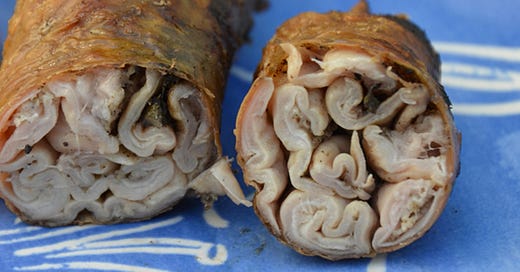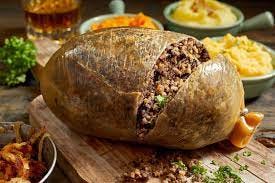A HAGGIS.
One of my earliest memories of French cuisine dates back to when I first moved to Paris. A friend took me on a walk through rue Mouffetard market. It was a chance for her to polish her inexpert English; in particular to practice with the letter “h”. Her solution was to scatter it indiscriminately through her conversation, hoping it would occasionally fall in the right place.
We stopped by a charcuterie where the owner was offering samples, and each took a slice of sausage.
“His andouillette,” she said, nibbling. “His very good ‘ere.”
Most French sausages are an agglomeration of meat, fat and filling, jumbled in a marmoreal mosaic, but this was filled with wobbly worm-like structures, and gave off an odd smell.
“What’s it made of?” I asked.
“Les tripes.” She searched for the word, but I knew what tripes were. Guts. And there was a curious odor.
“What’s the smell?”
“ ’e say,” she continued, after consulting the charcutier, “zat zis is zer real andouillette. Made à l’ancienne. In zer old way. It use le trou du cul. ‘
I looked blank.
“Comment se dit…?” She searched her vocabulary for the mot juste. “Ah yes. Trou du cul. Is zer hasshole!’”
ANDOUILLETTES
I don’t know how you feel about intestines. The French enjoy them more than most, though not as much as the Italians. Think of the feast staged by Trimalchio in Petronius's Satyricon, at the climax of which a huge pig is carried in.
“One and all, we expressed our admiration. Presently, Trimalchio, staring harder and harder, exclaimed “What! Isn’t it gutted? Call the cook.”
The cook came and stood by the table, looking crestfallen and saying he had clean forgot.
‘What? Forgotten?” cried Trimalchio. ‘Strip him!’
We all began to intercede for him, saying, ‘Accidents will happen. Forgive him this once.’
Trimalchio, a smile breaking over his face, said, ‘Well, as you have such a bad memory, gut him now, where we can all see.’
With trembling hand, the cook slashed open the animal’s belly. Out tumbled quantities of sausages and black puddings. At this, all the servants applauded like one man. The cook was rewarded with a goblet of wine and a silver wreath.”
Fragments of this showmanship survive in our own time. Think of the Thanksgiving and Christmas turkey or sucking pig, served whole, and carved at the table. And then there’s the jewel in the navel of Hibernian cuisine, the haggis.
In a miniature variation on the Roman pig stuffed with its own sausages, haggis is made from a sheep’s stomach, crammed with oatmeal, onions, spices and the chopped kidneys, heart and liver. This is then steamed until the interior reaches the consistency of a slightly crumbly meatloaf. It may not excite the appetite of every gourmet, but Burns loved it, even composing a poem in its honour.
Address to a Haggis must be the most passionate tribute ever penned to any dish, let alone one made with what American supermarkets call “Variety Meats” but the British frankly label “Offal”. Describing haggis as the “great chieftain o' the puddin’-race”, Burns, writing in dialect, suggests that a true Scot would cheerfully subsist on nothing else.
Ye Pow'rs wha mak mankind your care,
And dish them out their bill o 'fare,
Auld Scotland wants nae skinking ware
That jaups in luggies;
But, if ye wish her gratefu' prayer,
Gie her a Haggis!
Which translates roughly as:
You powers who make Man your care
And dish them out their bill of fare,
Remember Scotland doesn’t care
For gravied dishes.
But if you wish her grateful prayer
Give her a haggis!
The Piping of the Haggis takes place today, the 25th January, birthday of Scotland’s revered poet, Robert Burns. The poem is recited as the dish is brought to the table, preceded by a bagpiper. After a lengthy dedication - Burns dictates “a grace as lang’s my arm” - the host carves it up and serves his guests. This, at least, is how it should go, but as Burns himself remarked, “the best-laid schemes o' mice an' men gang aft agley” – the best plans of mice and men often go wrong.
At a Burns Night in an Australian university in the 1960s, a giant haggis was paraded around the hall, much admired for the way it conformed to Burns’s description of juices oozing through the skin: “while thro' your pores the dews distil/Like amber bead.”
The college chef confided to friends that he’d cooked it in his latest acquisition, an industrial-sized pressure cooker. Somebody in the physics department, overhearing, started to explain that, under such conditions, a permeable membrane – a sheep’s stomach, for example – can absorb an enormous amount of pressure which has no way to escape.
Just then, the chaplain concluded his grace. The college president rose in his formal robes, picked up a carving knife...
The explosion was audible all over campus.
Ever tried to get sheep’s entrails off a chandelier?






Hi John, the first time I ate Haggis was in Paris in 1976.I was working at Berlitz at the time. A fellow teacher was a former member of the Scottish Opera,and often seen around Paris in full Scottish regalia. He brought the Haggis back from his Scottish Xmas and a wonderful Bobby Burns night ensued.